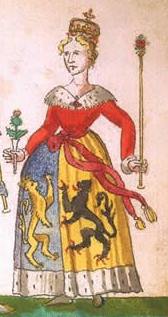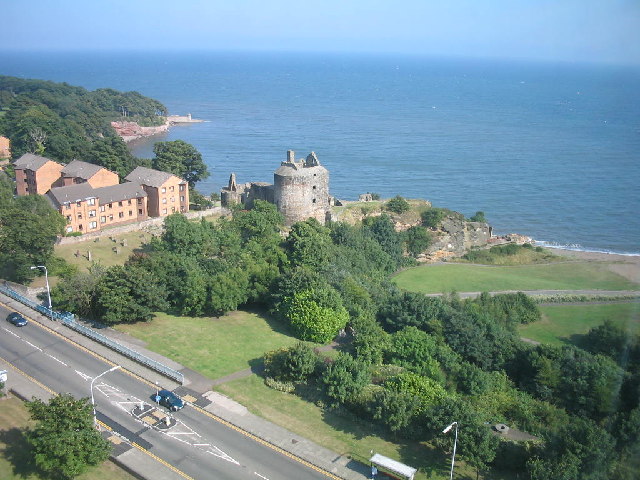by Susan Flantzer
© Unofficial Royalty 2017

Credit – Wikipedia
Mary of Guelders, wife of James II, King of Scots, was born around 1434, the eldest of the five children of Arnold, Duke of Guelders and Catherine of Cleves. The Duchy of Guelders was located in the present Dutch province of Gelderland (in English Guelders), the present Dutch province of Limburg, and parts of the present German state of North Rhine-Westphalia. Mary’s mother Catherine was the daughter of Adolph I, Duke of Cleves and Marie of Burgundy. Adolph and Marie were the great-great-grandparents of Anne of Cleves, the fourth wife of King Henry VIII of England.
Mary had four siblings:
- William (born circa 1434), died young
- Margaret of Guelders (1436–1486), married Friedrich I, Count of Palatine-Simmern, had ten children
- Adolf, Duke of Guelders (1438–1477), married Catherine of Bourbon, had two children
- Catherine of Guelders (1439–1496), Regent of Geldern in 1477–1481, unmarried
Mary was educated in the court of her great uncle Philip the Good, Duke of Burgundy and his third wife Isabella of Portugal, a granddaughter of John of Gaunt, son of King Edward III of England. Isabella had been well educated by her parents King João I of Portugal and Philippa of Lancaster. She was known for her intelligence, patronage of the arts, and political influence on her husband and son. She was a great influence on Mary and helped arrange Mary’s marriage to James II, King of Scots.

Mary’s great uncle Philip the Good, Duke of Burgundy; Credit – Wikipedia
Philip and Isabella had planned to betroth Mary to Charles, Count of Maine, but her father could not pay the dowry. Negotiations for a marriage to James II, King of Scots began in July 1447 when a Burgundian envoy went to Scotland and were concluded in September 1448. Philip promised to pay Mary’s dowry, while Isabella paid for her trousseau. Philip the Good, Duke of Burgundy settled a dowry of 60,000 crowns on his great-niece and Mary’s dower (given to a wife for her support if she should become widowed) of 10,000 crowns was secured on lands in Strathearn, Athole, Methven, and Linlithgow in Scotland. William Crichton, 1st Lord Crichton, Lord Chancellor of Scotland came to Burgundy to escort Mary to Scotland, where they landed at Leith on June 18, 1449. 15-year-old Mary married 19-year-old James II, King of Scots, at Holyrood Abbey in Edinburgh, Scotland on July 3, 1449. Immediately after the marriage ceremony, Mary was dressed in purple robes and crowned queen.

James II, King of Scots; Credit – Wikipedia
Mary and James had seven children:
- Unnamed son (born and died May 19, 1450)
- James III, King of Scots (1451 – 1488), married Margaret of Denmark, had three sons including James IV, King of Scots
- Mary Stewart (1453 – 1488), who married (1) Thomas Boyd, 1st Earl of Arran, marriage annulled, had two children (2) James Hamilton, 1st Lord Hamilton, had three children, great-great-grandparents of Henry, Lord Darnley (the second husband of Mary, Queen of Scots)
- Alexander Stewart, Duke of Albany (circa 1454 – 1485), married (1) Lady Katherine Sinclair, had two sons, marriage annulled (2) Anne de la Tour d’Auvergne, had two children; Alexander was killed in a duel by the Duke of Orléans (the future King Louis XII of France)
- Margaret Stewart (born circa 1455), mistress of and possibly married William Crichton, 3rd Lord Crichton of Auchingoul, had one daughter
- David Stewart, Earl of Moray (circa 1456 – 1457), died young
- John Stewart, 1st Earl of Mar and Garioch (circa 1459 – 1479), unmarried, accused of treason, died under suspicious circumstances
On August 3, 1460, 29-year-old James II, King of Scots was accidentally killed when a cannon nearby where he was standing exploded. Mary became the regent for her nine-year-old son King James III.
Mary indirectly participated in the English Wars of the Roses when she gave refuge in Scotland to Margaret of Anjou, Queen of England and Edward of Westminster, Prince of Wales, the wife and son of the Lancaster King Henry VI of England, keeping them out of the hands of the Yorkists. Mary even arranged to give Margaret Scottish troops and the two queens arranged a preliminary betrothal between Margaret’s son and Mary’s youngest daughter Margaret. However, any arrangements the two queens made came to naught. Mary’s uncle Philip the Good, Duke of Burgundy made an alliance with the Yorkist King Edward IV of England. Edward IV even proposed a marriage with Mary which Mary rejected. Mary’s uncle pressured her to call off the betrothal of her daughter and Prince Edward, to Margaret’s disappointment. In 1462, Mary paid the Lancastrian royals to leave Scotland and made peace with Edward IV.
Before his death, James II was planning the construction of a new castle, Ravenscraig Castle, as a home for Mary. After her husband’s death, Mary began the construction of the castle as a memorial to him and as a dower house for herself. Mary lived in the castle until her death, when only the east tower and the basement of the central section had been built.

Ravenscraig Castle; Photo Credit – By Ian Mitchell, CC BY-SA 2.0, https://commons.wikimedia.org/w/index.php?curid=9167584
Mary of Guelders survived her husband by only three years, dying on December 1, 1463, at the age of thirty. She was buried in Trinity College Kirk in Edinburgh, Scotland which she had founded three years before in memory of her husband. In 1848, despite a formal protest from the Society of Antiquaries of Scotland, Trinity College Kirk was demolished to allow for the construction of the Waverley Railroad Station. At the time of the demolition, Mary’s remains were moved to Holyrood Abbey in Edinburgh.

The vault containing the remains of Mary of Guelders at Holyrood Abbey; Photo Credit – www.findagrave.com

Plaque on the vault containing the remains of Mary of Guelders at Holyrood Abbey; Photo Credit – Connie Nissinger – www.findagrave.com
This article is the intellectual property of Unofficial Royalty and is NOT TO BE COPIED, EDITED, OR POSTED IN ANY FORM ON ANOTHER WEBSITE under any circumstances. It is permissible to use a link that directs to Unofficial Royalty.
Works Cited
- Ashley, Michael, and Julian Lock. The Mammoth Book Of British Kings & Queens. London: Constable & Robinson, 2012. Print.
- “Guelders”. En.wikipedia.org. N.p., 2017. Web. 6 June 2017.
- “James II Of Scotland”. En.wikipedia.org. N.p., 2017. Web. 6 June 2017.
- “Mary Of Guelders”. En.wikipedia.org. Web. 6 June 2017.
- “Scottish Royal Burial Sites”. Unofficial Royalty. Web. 27 May 2017.
- Williamson, David. Brewer’s British Royalty. London: Cassell, 1996. Print.
